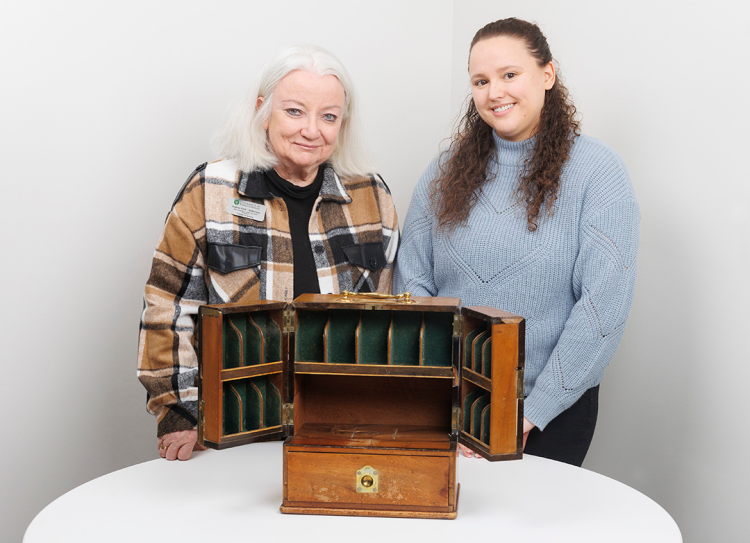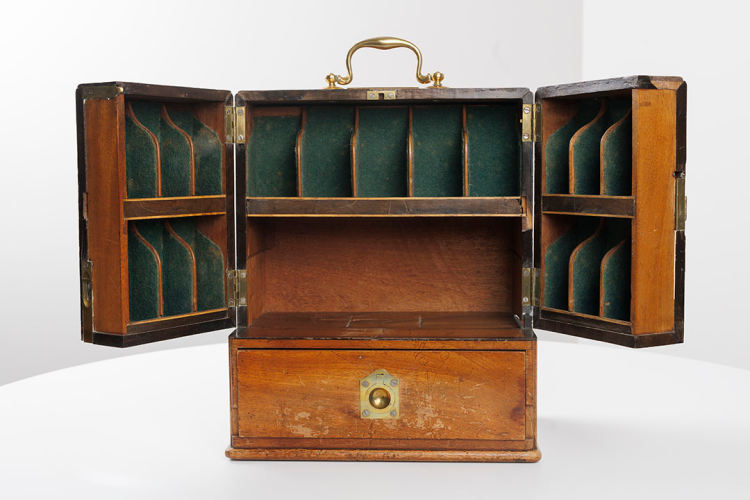New research on the Florence Nightingale medicine chest traces the history of the artifact's arrival at the University of Saskatchewan (USask).
Students at the University of Saskatchewan (USask) College of Nursing generally become aware at some point during their studies that the college has an impressive artifact in its midst - a medicine chest that renowned founder of modern nursing Florence Nightingale used in her care for wounded soldiers.

Dr. Arlene Kent-Wilkinson (left), alongside research assistant Dr. Letitia Johnson (PhD), and the historic Florence Nightingale medicine chest. (Photo: Dave Stobbe)
While some students and alumni will drop by to spend a few minutes with the chest, imagining the instruments and medicine that may have rattled around inside, College of Nursing Professor Dr. Arlene Kent-Wilkinson (PhD) has spent significantly more time, verifying the chest's authenticity, tracing how it came to the university, and most recently, even connecting with the descendants of the original donors, who ensured its safety as a prized possession at USask College of Nursing.
Arriving in Saskatoon in 1912 and at the university around 1956, the Nightingale medicine chest has resided in many locations over the years but is currently in a five-foot display case located on the fourth floor of the Health Sciences Building E-Wing.
Made of dark brown wood, the case is lined with green baize and features double-opening front doors with compartments and a drawer along the bottom. There is also a secret compartment at the back, which would have been used to store hazardous medications of that time. Nightingale would have used chests like this to treat soldiers in the Crimean War, 1854-56, when she developed a reputation not only for her nursing, but for reducing death rates among soldiers by improving hygiene.
Kent-Wilkinson said she has always been motivated by the sense of history and mystery surrounding the case, the latter of which has become much clearer thanks to her efforts.
"It's a piece of our history; it's nursing history. It really matches the trajectory of what was happening in society then and now, especially with the recent COVID-19 pandemic, when we used all of the skills that Nightingale promoted: the hygiene, the distancing in overcrowded conditions, etc. She knew all of that and it became so important again when the pandemic happened."

The University of Saskatchewan's College of Nursing is home to Florence Nightingale's medicine chest. (Photo: Dave Stobbe)
By accessing genealogy databases which contained immigration records and country census, Kent-Wilkinson was able to correct details that had been incorrectly recorded and provide additional validation for the case.
By tracing the medicine chest's movements from its origins in England to its current display case, Kent-Wilkinson has confirmed Nightingale's sister, Lady Frances Verney, gave the medicine chest to her gardener Isaac Milsom and his wife Mary Ellen. The Milsom family then immigrated to Canada in 1912 with their seven children. Isaac Milsom was hired as a landscaper for the city of Saskatoon, where he also became friends with Dr. Hugh Dalton Weaver and his wife Alice. Milsom gifted the medicine chest to the Weavers around 1918. In the 1950s, the medicine chest was donated by the Weaver estate to the University of Saskatchewan.
For Kent-Wilkinson, a passion for history and genealogy led her not only to confirm these details, but also to add to the story. While the Weavers didn't have children, they did have a nephew, Lewis H. Thomas, who they raised as their own from the age of 14. He attended the university and eventually became the provincial archivist for Saskatchewan.
Through document searches on newspaper articles with the help of Tim Hutchinson, University Archives and Special Collection at USask, and Archivist Jeff O'Brien at the Saskatoon StarPhoenix, together they were able to show the connections with all the chest's custodians over the years. Kent-Wilkinson was also able to identify the living relatives of the last custodian of the chest, Dr. Lewis H. Thomas, through a genealogy website.
A faculty member at the College of Nursing since 2002, Kent-Wilkinson focuses her research and teaching on mental health and addiction, forensic nursing, and Indigenous health. While her busy teaching schedule had meant that the mysteries of the medicine chest had to be something she pursued in her spare time, in 2022 she received a Social Sciences and Humanities Research Council grant to finally gather some answers to the research project she titled, Exploring the Secrets and Provenance of the Florence Nightingale Medicine Chest in Canada.
"The question was, did this chest really belong to Florence Nightingale?' We had the research question for years, and no one thought of it as a research project," said Kent-Wilkinson, adding that a second question was around whether Nightingale had actually used this chest in the Crimea.
With the grant in place and questions set, Kent-Wilkinson hired Dr. Letitia Johnson (PhD) as a research assistant to pursue these questions and partnered with fellow College of Nursing faculty member Dr. Helen Vandenberg (PhD), who has a focus on nursing history, to help validate what everyone thought they knew about the chest.
"It's a piece of our history; it's nursing history."
Dr. Arlene Kent-Wilkinson (PhD)Last Updated: April 29, 2025
Then Kent-Wilkinson took the extraordinary step of finding the living relatives of Alice Weaver and meeting them online. In 2024, with the help of a second research assistant, Leegay Jagoe, they set up a meeting with the two children of Dr. Lewis H. Thomas, Jeannie and Robert.
"We had a couple of zoom interviews with them, and it was amazing because what we found really validated the medicine chest, because it was a family story," said Kent-Wilkinson.
"The adult children recall their father bringing the chest into their house in Regina around two years after their aunt passed away and getting a plaque made to put on the top of the chest to commemorate the donation from Dr. and Mrs. Weaver. Robert remembers when he was about six years old, his father bringing the medicine chest home to their house in Regina, and it sitting on the coffee table. He remembers opening the doors of the chest and seeing the green cubicles, and thought it was a neat old chest," said Kent-Wilkinson.
Jeannie, who was two years older than her brother when the medicine chest would have entered the house, does not remember it, but did recall lots of family conversations about Nightingale and that there was a family connection.
Kent-Wilkinson said Robert was also able to send her photographs from their family album, which were the originals of pictures from articles in the early Saskatoon Daily Star and StarPhoenix, that further validated the medicine chest and the families' whereabouts. In another serendipitous connection, Jeannie mentioned they happened to live next door to universal health care founder and provincial premier Tommy Douglas, who often visited their home.
While the official research project is now complete, Kent-Wilkinson still has big plans for the chest.
She arranged for professional photographs to be taken and has created a standup banner for the project. She's planning a new display for when the chest is moved to its next place of honour in A-wing of the Health Sciences Building, something that would show its background more visually with a map and other cues.
"The medicine chest itself is not going to tell the story, but a map of the world behind it with the arrows from England to the Crimea in 1854, then from England to Saskatoon in 1912 are going to show where it originated and that it belonged to Florence Nightingale," she said.
As for future plans for the case, Kent-Wilkinson said there are many possibilities, including creating memorabilia around the artifact, student scholarships, getting the chest valued by experts and even loaning it to the Florence Nightingale Museum in London, England, where Kent-Wilkinson had noticed a smaller medicine chest that spurred her further research on the University of Saskatchewan artifact.
For now, the case stands affirmed and ready to receive further admirers visiting the College of Nursing.
"I often say the medicine chest waited for us for over 100 years to do this research," Kent-Wilkinson said.













